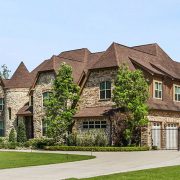Energy Efficient Materials To Use In A New Custom Home
 Having an energy-efficient home is a plus in the home industry. If you’re building a new home using energy-efficient materials, you not only can improve your utility bills and help the environment but also enhance your home’s value. Professionals in the industry report that energy efficiency is becoming so important that they’re developing more energy-efficient materials all the time. These can be from using eco-friendly light bulbs to eco-friendly housing materials. If you are unsure of what to use for a new home here are 10 energy-efficient materials.
Having an energy-efficient home is a plus in the home industry. If you’re building a new home using energy-efficient materials, you not only can improve your utility bills and help the environment but also enhance your home’s value. Professionals in the industry report that energy efficiency is becoming so important that they’re developing more energy-efficient materials all the time. These can be from using eco-friendly light bulbs to eco-friendly housing materials. If you are unsure of what to use for a new home here are 10 energy-efficient materials.
1. Recycled Steel
Metal is one of the most recycled materials out there and is very easy to recycle. Metal roofs and other metal construction materials can be made of recycled steel. Reports show that 60% of new steel is actually made from old steel. The benefits of using recycled steel are lower CO2 emissions, lighter weight, and durability. It is a perfect recycled material to use in the construction of your new home.
2. Spray Foam Insulation
Insulation is very important when it comes to insulating your home. Spray foam has a low energy leakage and is a great insulator year-round. Spray foam gives off no harmful emissions making it safe for the environment and for your home’s indoor quality. The benefits of spray foam are it is shrink-proof and water-resistant.
3. Smart Thermostat
Smart thermostats can actually learn your climate preferences. This will help your home stay comfortable when you are home and less comfortable while you are away. This helps save energy and maintain a comfortable environment at the same time.
4. Low-E, Dual Pane, Or Triple Pane Windows
Reports say that around 30% of the heating and cooling costs in a home are due to the energy that seeps out through your windows. Low-E windows will reduce the energy that can be lost through windows. They can also block harmful rays such as UV rays and infrared rays.
Homeowners can purchase both dual-pane and triple-pane windows. These are very energy efficient. Dual-pane windows are more popular than triple-pane because they are lighter weight, thinner, and less expensive.
5. Cool Roof
A dark-colored roof can make an attic reach upwards of 150 degrees on a hot summer day whereas a white roof reflects light back keeping your attic cooler. Cool roofs are not just white roofs but can be made out of steel, asphalt, shingles, and more.
6. Solar Panels
Solar panels are great because they take the energy from the sun to generate power for your home. There are solar shingles now that are more aesthetically pleasing for your curb appeal. Solar panels can be purchased and even leased.
7. Plastic Composite Lumber
One problem with wood is that it can rot. Homeowners are very familiar with replacing rotten wood. A more economical way to preserve your home building materials is to use plastic composite lumber. Plastic composite lumber is made up of wood pulp and resins. This building material can look like wood but can withstand exposure to moisture. This material is perfect to use for decks or fences.
8. Thermostat Radiant Barrier
Thermostat radiant barriers function in ways that are similar to cool roofs. Thermostat radiant barriers reflect sunlight to keep your house cool. Your energy bill can go down as much as 17% during the hottest days in the summer.
9. Natural Insulators
Denim is a great natural insulator because it is made from recycled blue jeans. Wool is one that can be a great insulator and is fire resistant and will not mold or rot. Straw bales can be great insulators and can last for thousands of years if it is kept dry.
10. Plant-Based Polyurethane Insulators
Plant-based polyurethane insulators are great and environmentally friendly. These can be made from bamboo, hemp, and kelp. They are resistant to moisture and heat which is a plus.
Remember it is best to work with a contractor who is familiar with building a green home. These contractors are used to working with energy-efficient building materials.










